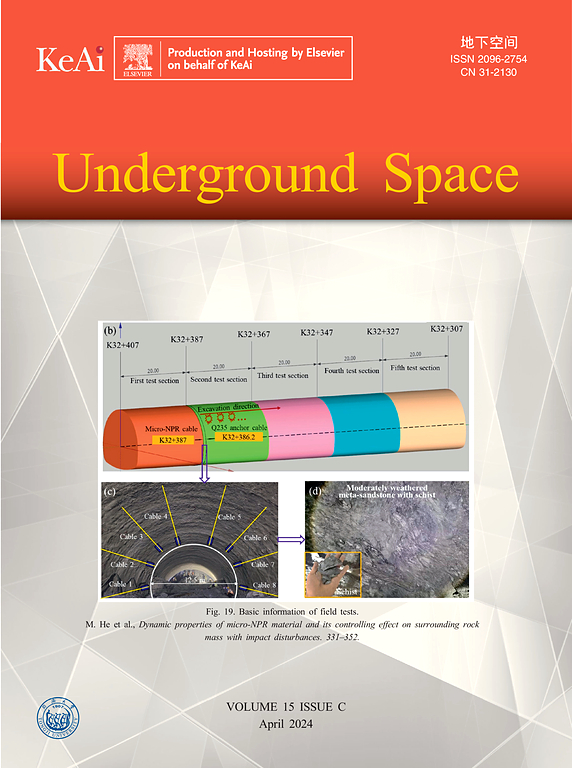Bleed-off control on post-injection seismicity in enhanced geothermal systems
IF 8.3
1区 工程技术
Q1 ENGINEERING, CIVIL
引用次数: 0
Abstract
Deep geothermal reservoirs could provide widespread access to clean and renewable energy around the world. However, hydraulic stimulation of these reservoirs to create sufficient injectivity and heat extraction has frequently induced earthquakes during and, in particular, after reservoir stimulation, which raises public concerns. This study aims to provide a possible explanation for post-injection seismicity and understand how it responds to well bleed-off as a common industrial practice to control such seismic activity. To this end, we perform coupled hydromechanical simulations of reservoir stimulation in a conceptual model comprising a deep granitic reservoir intersected by a network of long fractures and a nearby, critically-stressed fault. We find a combination of mechanisms triggering post-injection seismicity with time delays of several months after stopping injection: (1) poroelastic stressing that transmits normal and shear stress and causes undrained pressure buildup on the fault, (2) fracture-dominated pore pressure migration toward the fault, and (3) long-lasting along-the-fault pressure diffusion toward pre-stressed fault patches, promoted by dilation-induced fault permeability changes. In this setting, bleed-off causes rapid pressure decline in the near-wellbore region but marginal pressure changes farther away. The resulting attenuations of pore pressure and shear stress on the fault plane may not be enough to prevent fault reactivation. Bleed-off may counterintuitively accelerate fault slip by rapid relaxation of normal stress on the fault, which not only brings the stress state closer to failure conditions, but also accelerates pore pressure diffusion along the fault by slightly increasing its permeability. We show that bleed-off can effectively control post-injection seismicity only if rupture initiates from a structure in close proximity and with sufficient hydraulic connection to the wellbore. Future research should be directed toward the optimization of stimulation and post-stimulation design in light of the involved triggering mechanisms and through effective combination with subsurface characterization to control post-injection seismicity.
增强型地热系统注入后地震活动性的溢流控制
深层地热储层可以为世界各地提供广泛的清洁和可再生能源。然而,为了创造足够的注入能力和提取热量,对这些储层进行水力压裂常常会在储层压裂期间和之后引发地震,这引起了公众的关注。本研究旨在为注入后地震活动提供一种可能的解释,并了解作为控制此类地震活动的常见工业实践,它是如何响应井漏的。为此,我们在一个概念模型中对储层增产进行了耦合流体力学模拟,该模型包括一个由长裂缝网络和附近的临界应力断层相交的深部花岗岩储层。我们发现,在停止注入后几个月,触发注入后地震活动性的机制有以下几种:(1)孔隙弹性应力传递正应力和剪应力,导致断层上不排水的压力积聚;(2)裂缝主导的孔隙压力向断层迁移;(3)膨胀引起的断层渗透率变化促进了沿断层向预应力断层斑块的长期压力扩散。在这种情况下,漏失会导致近井区域的压力迅速下降,但在更远的地方,边际压力会发生变化。由此产生的断层面孔隙压力和剪应力的衰减可能不足以防止断层再激活。漏液可能会通过断层上的正应力快速松弛而加速断层滑动,这不仅使应力状态更接近于破坏条件,而且还会通过略微增加断层的渗透率来加速孔隙压力沿断层的扩散。研究表明,只有当破裂发生在靠近井筒且与井筒有充分水力连接的结构中时,泄油才能有效控制注入后的地震活动性。未来的研究方向应是根据所涉及的触发机制,通过与地下表征的有效结合,优化增产和增产后设计,控制注后地震活动性。
本文章由计算机程序翻译,如有差异,请以英文原文为准。
求助全文
约1分钟内获得全文
求助全文
来源期刊

Underground Space
ENGINEERING, CIVIL-
CiteScore
10.20
自引率
14.10%
发文量
71
审稿时长
63 days
期刊介绍:
Underground Space is an open access international journal without article processing charges (APC) committed to serving as a scientific forum for researchers and practitioners in the field of underground engineering. The journal welcomes manuscripts that deal with original theories, methods, technologies, and important applications throughout the life-cycle of underground projects, including planning, design, operation and maintenance, disaster prevention, and demolition. The journal is particularly interested in manuscripts related to the latest development of smart underground engineering from the perspectives of resilience, resources saving, environmental friendliness, humanity, and artificial intelligence. The manuscripts are expected to have significant innovation and potential impact in the field of underground engineering, and should have clear association with or application in underground projects.
 求助内容:
求助内容: 应助结果提醒方式:
应助结果提醒方式:


